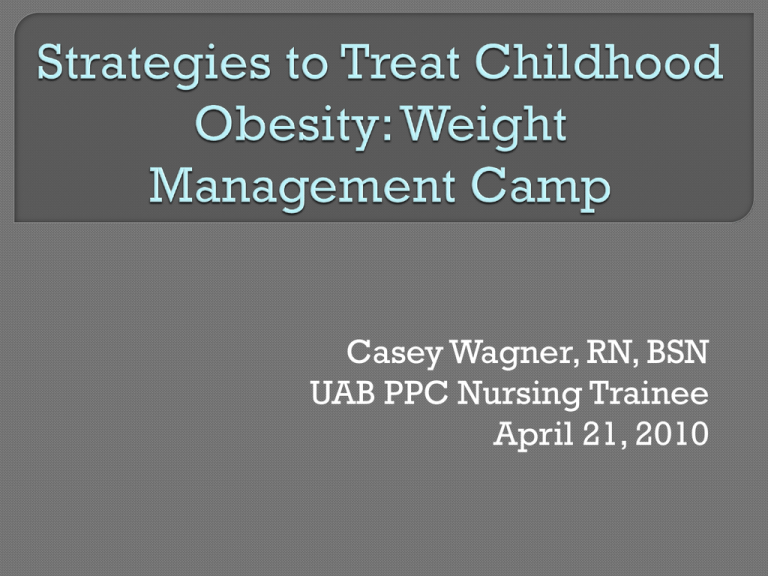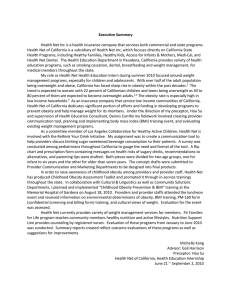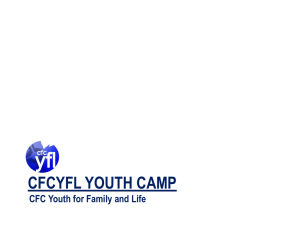Parental Involvement in Summer Camp Program for Pediatric
advertisement

Casey Wagner, RN, BSN UAB PPC Nursing Trainee April 21, 2010 Explain the gravity that the childhood obesity epidemic has on Child Health. State the physiological imbalance that causes overweight and obesity. Name three psychosocial factors that contribute to overweight and obesity in children. Describe one piece of evidence that a weight management camp is effective in treating childhood obesity. Childhood Obesity Current Evidence-based Treatment Strategies Gaps in the Literature Children’s Health System of Alabama Clinic for Weight Management (CCWM) CCWM Camp S.H.I.N.E. Casey’s Evidence-Based Practice Project: Parental Involvement Program (PIP) Childhood Overweight and Obesity Obese children and adolescents are at risk for health problems during their youth and as adults Obese children and adolescents are more likely to become obese as adults (Centers for Disease Control & Prevention, 2009) For children and adolescents (aged 2–19 years), the BMI value is plotted on the CDC growth charts to determine the corresponding BMI-for-age percentile. Overweight is defined as a BMI at or above the 85th percentile and lower than the 95th percentile. Obesity is defined as a BMI at or above the 95th percentile for children of the same age and sex. [(Barlow SE & the Expert Committee, 2007) & (Centers of Disease Control and Prevention, 2009)] 31.7% of children and adolescents ages 2-19 years are overweight 17 % of children and adolescents ages 219 years are obese 11.9% are at or above the 97th percentile of the BMI-for-age growth charts [(Ogden et al., 2010) from (NHANES, 2007-2008)] BASICALLY, people become overweight when they CONSUME TOO MANY calories (eating and digesting) and EXPEND TOO FEW calories (sedentary activities and lack of exercise) BUT… what causes these behaviors? This model recognizes the interwoven relationship that exists between the individual and their environment Individuals are responsible but behavior is determined to a large extent by social environment Barriers to healthy behaviors are shared among the community The most effective approach is a combination of efforts at all levels (Wilson, 2001) Weight Management for Pediatric Patients According to Gillis et al. (2005), research suggests children already in enrolled in a weight management program will gain weight in summer months when compared to weight gain in the other seasons of the year Retrospective cohort study with 73 participants from the pediatric wt. mgmt. center in Ontario, Canada Implications: Develop ways to deal with summer vacation period for obese children and adolescents! Also, authors suggest that families need to be aware and involved Depends on what you’re looking at… • Study’ s measurements • Type of camp • Cost 8-week multi-disciplinary residential summer camp 1700 calorie/day diet, daily calisthenics workouts, resistance weight training, integrated sports activities, nutrition classes, and weekly sessions with a psychologist Short-term Results: an average of 8.3% BMI reduction, circumference measurements decreased Physical ability did not increase significantly High price tag = approximately $1,000/wk (Cooper et al., 2006) 8-week residential camp, also in North Carolina 1,800 calorie/day diet, nutrition class 2/wk, cooking class 1/wk, 1-hour physical activity sessions 5/day, weekly psychosocial group Findings: • Length of stay correlated significantly with weight loss • decreased anti-fat attitudes and value placed on appearance • increased body esteem, self-esteem, and weight/eating efficacy 6-week, residential camp at a boarding school’s facilities Dietary restriction based on metabolic rate, 6 1-hour physical activity sessions/day, and 4 education sessions/week Results = ↓ body mass, BMI, body fat, and waist and hip circumference with statistical significance and ↑ self-esteem, sports skills Greater improvement with longer duration of stay (Gately et al., 2005) Camp literature doesn’t explore parental involvement Aim: To determine contributions of family and neighborhood environments on changes in youth physical activity and BMI over 5 years Methods: Longitudinal cohort study of 10- to 12year olds in Melbourne, Australia Results: Physical activity ↓ and BMI z-score ↑ over the 5 years • Factors in the home environment were more often associated with physical activity and BMI than either perceived or objective measures of the local neighborhood environment (Crawford et al., 2010) Story et al. (2002) report the most frequent barriers cited by practitioners overall were: • lack of parent involvement • lack of patient motivation • lack of support services Data from a large national survey of pediatricians, PNPs, and RDs to evaluate attitudes, assessment methods, and treatment practices in the management of childhood obesity Reiterates that there is critical need for exploring strategies to reduce barriers in treatment of obesity Stages of Change Model (Rhee et al., 2005) Aim: describe demographics and parental perceptions associated with readiness to make weight-reducing lifestyle changes for their overweight children Findings: 38% preparation or action, 17% contemplation, and 44% precontemplation Parents who thought their child’s weight was a health problem had 16x the odds of being in preparation/action After an exhaustive review, no studies were found that examined parental involvement in residential weight management camp. 6-week program attended by 12-15 y.o. with obesity - weekly parent education groups Program did not have explicit goal of weight loss • Included exercise, field trips, nutrition class, cooking & shopping groups, trips to supermarkets and restaurants, behavioral therapy group, art therapy, and yoga No significant changes in anthropometrics, lab values, eating behaviors, or family functioning Improvements in quality of life, the stages of change, and ↑ physical activity (Kotler et al., 2006) Framework: lifestyle enhancement and family involvement would improve children’s health Aim: evaluate the effects of a hospital-based, family-centered lifestyle program on weight and health in overweight 7-17-year-olds Intervention: 12 90-minute sessions held 1x/week at local children’s hospital Results: significant in BMI, child perceived health & function, improved family cohesion (Dreimane et al., 2007) Aim: To develop and test the feasibility and acceptability of HOME program, a pilot childhood obesity prevention program aimed at increasing quality foods in the home environment and during family meals (Fulkerson et al., 2010) Results: 86% of families attended at least four of the five sessions Parents and children were very satisfied with the program Children significantly more likely to report improved food preparation skill Trends suggesting that intervention children had higher consumption of fruits & vegetables, ↑ intake of key nutrients Birmingham and Central Alabama’s treatment program for childhood overweight and obesity http://weight.chsys.org/ Interdisciplinary focus: Pediatrician, Surgeon, RN, PNP, RD, PT, & Psychologist Long wait to get 1st appointment (~8 months) Goal: assist families in making permanent behavior changes that result in weight loss, improved health, & greater sense of well-being CCWM’s summer camp Pilot a 1-week, residential weight management summer camp program with comprehensive educational offerings, focused on healthy eating and physical activity, for overweight children and their families, and evaluate the positive health and psychological effects Will a Parent Involvement Program (PIP), designed to engage & educate parents of camp attendees, improve parents’: • Readiness to Change, • Self-Perceived Progress towards Healthy Lifestyle Goals, • Perceptions of Child’s Quality of Life? Participants will be overweight children, aged 10- to 14-years old, and their parents Recruitment through the patients of CCWM with appointments in the last year or who are on the waiting list Exclusion Criteria: Children with a developmental delay, physical limitation, or are not fluent in English Randomized control trial, with n = 15 for intervention and control group Camp Kick-Off educational session on Sunday afternoon with parents Mid-week phone call during camp End of Camp session on Saturday Administer the Child Behavior Checklist, Impact of Weight on Quality of Life- Parent form, Readiness to Change tool, & Project Eat Survey before camp and 1 month post camp Administer the PIP Goals Survey at kick-off and 1 month post camp 1. It is important to set goals for a healthy life. Please use this pack of cards to rank your goals for your home. Label the back of each card with a number, with 1 being the most important to you and 10 being the least important. If none of the listed matches your top personal goal, use the wild card to write it in. 2. On a scale of 1 to 10, how close are you to reaching your top goals? (1 = Very far; 10= Goal Met) 3. Please use the second pack of cards to rank the top barriers to reaching your goals. Label the back of each card with a number, 1 being the top barrier to you and your family, and 10 being the least of a barrier. If none of the listed matches your top barrier, use the wild card to write it in. 4. On a scale of 1 to 10, how confident are you that you and your family can make progress towards reaching the goals? (1= Not at all; 10= Very much) 5. On a scale of 1 to 10, how important is it to you to reach your goals? (1= Not at all; 10= Very much) CAUTION: CASEY AT WORK Strategies discussed today could be applied to the care of children with many, various chronic health care needs Ideal Programs with Family-Centered Care & Parental Involvement Must consider the theories of the SocioEcological Model, Behavior Change THANK YOU VERY MUCH!







